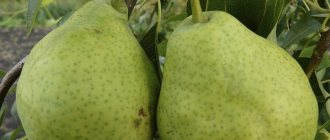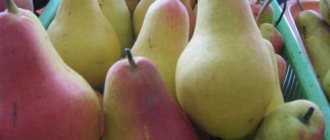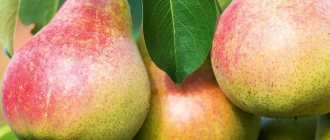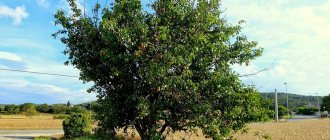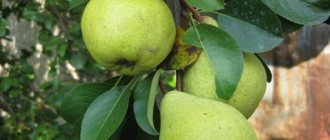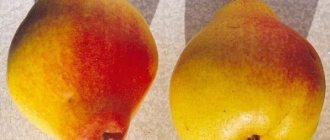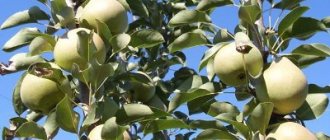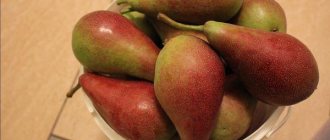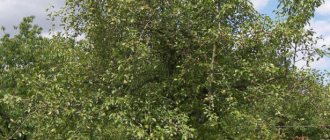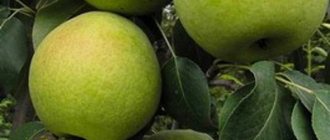Bere winter Michurina
Description of the variety
Bere Michurina is a late-ripening variety and has good keeping quality. The pear is zoned for cultivation in the Lower Volga and Central Black Earth regions.
Characteristics of wood
Trees of this variety are tall and strong. The crown is wide, well leafy, and has a pyramidal shape. Young shoots have a green tint. The foliage is yellow-green, oval in shape and has wavy edges.
Description of fruits
The fruits are small and their weight ranges around 90-100 grams. The pear shape is slightly shortened, with slight ribbing. When picked from the tree, pears have a pale green color with a slight blurred blush on the sunny side.
During storage, the base color becomes yellow and the blush becomes more intense. The taste of this variety is satisfactory. The fruits are sweet, juicy, with a pronounced tartness. The harvest is harvested at the end of September and stored until March.
Bere winter Michurina.
Bere pear variety: varieties
Pear Bere Ardanpon photo
Bere pear has several well-known varieties. All of them have interesting specifics: ripening time, appearance, ripeness, resistance to cold and sudden temperature changes. The most famous varieties are listed below:
- "ardanpont".
This variety is classified as a winter variety. The variety was obtained in Belgium in the eighteenth century. The fruit crop was named after its developer. The pear tree grows high. The crown has the shape of a regular pyramid and is quite dense. The crop is large in size, pear-shaped or bell-shaped, with an uneven shell. The weight of one fruit is two hundred to two hundred and fifty grams. The pulp is snow-white in color, sweet in taste, with a slight tart aftertaste. The sugar content is estimated at ten point two percent. The skin is light yellowish in color, with a small number of brownish dots. The fruits have a long shelf life; up to about one hundred and forty days they do not lose their amazing taste. The characteristics mention that this variety can only be cultivated in the southern regions. Brings an average amount of harvest in Crimea. Low level of resistance to scab disease.
- "gardi".
The variety appeared in France. The fruit tree is powerful and grows high. The crown has the shape of a regular cone, there is an expansion towards the top, and the branches are powerful. The branches grow horizontally, there is a slight droop. The weight of one fruit is one hundred fifty to two hundred grams. The pulp is creamy, filled with juice, tastes sweet and sour at the same time, with a delicate aroma. The peel is compacted, not moist, the color is yellowish with brownish and reddish inclusions, which are visible only in sunlight.
This variety is not capricious in choosing a landing site. The harvest begins to bear fruit at the beginning of the autumn season.
- "yellow".
A selection variety whose native land is Russia. Also zoned for cultivation in the northern regions. In the circles of summer residents it is also referred to as “thrifty”. Fruit trees grow low and straight up. The crown has the shape of a circle. The leaves are light greenish in color, the front side of the leaf blade is not shiny, and there are jagged edges. Small flowers are collected in inflorescences. The weight of one fruit is one hundred grams. The fruits have the correct shape, and their surface has no unevenness. The skin color is light yellowish, there is no red tint. The pulp is tender, filled with juice. The seed chamber contains large seeds, dark in color. The taste of the fruit is sour and sweet at the same time. The amount of sugar in the pulp is estimated at eleven point two percent. The possibility of transportation over long distances is available. The harvest ripens at the end of the first autumn month.
- "giffard".
This variety came to us from the territory of France, and it appeared there in 1810 from seeds of an unknown formation. The fruit tree grows up to five hundred centimeters. During the stages of crop aging, growth slows down, and the amount of harvest and the level of resistance to cold increase.
The shoots are thin, red in color. The foliage is large, light greenish in color. When ripening, the crop forms into the correct shape. The surface of the fruit is not uneven, there are brownish dots. The pulp is filled with juice, melts in the mouth, tastes sweet and sour at the same time. The fruits ripen at the end of the first autumn month. The fruit-bearing process is weak. The weight of one fruit reaches fifty to one hundred grams. Kept in ripened form for three to five days. The fruit crop does not tolerate cold weather. This variety has a high level of resistance to fungal diseases.
- "gold".
This variety is considered a summer variety and was bred in Belarus. The fruit tree grows three hundred centimeters upward. The crown thickens abundantly, which means timely pruning is necessary. The tree begins to bear fruit when it reaches the age of five to six years. The fruits ripen in the third month of summer. The harvest quantity is large. Immediately after ripening, the fruits can be kept for a week or two. The variety is distinguished by a high level of resistance to various diseases, for example, scab and bacterial cancer.
Pear Bere Golden photo
- "klerzho".
This variety came to our country from Western Europe. The variety was named after its creator. The fruit tree grows upward to the usual height, the crown has the shape of a narrow pyramid. The foliage is small in size and tapering towards the end. The harvest is dense, with good taste and pleasant aroma. The fruits ripen in the first week of the first autumn month. The fruits should be picked immediately, otherwise they will fall off and lose their taste. The tree begins to bear fruit when it reaches the age of four to five years. In more northern regions, fruit crops need protection from the cold.
- "Krasnokutsky".
The fruit tree differs in its ordinary growth. Forms a crown in the shape of a regular cone, slightly rounded. With constant pruning, annual shoots are removed. The fruits are large in size, the weight of one fruit is two hundred to two hundred and fifty grams. The fruits have an elongated shape, are green and yellow in color at the same time, and have a brownish blush. The pulp is fatty, yellowish in color, filled with juice. The taste is sour and sweet at the same time, the pleasant smell is pronounced. Tasters rated the taste at four point five points on a five-point system.
The first fruits are formed in the fifth year of the tree's life. After another five years, it is possible to collect fruits with a total weight of up to fifty kilograms. Upon reaching the age of fifteen years, the weight of the crop increases to one hundred and twenty kilograms. The time for fruit ripening occurs in the first and second autumn months.
- "Crimean".
This variety is a breeding variety; breeding specialists obtained it in 1964 with the help of open pollination of another variety native to France. Fruit crops grow in normal sizes, have a crown with the shape of a regular pyramid, and are not thickened. The harvest is large in size, sometimes the weight of one fruit can reach up to five hundred and twenty grams, but most often the weight reaches three hundred and forty grams. The surface has unevenness and slight ribbing. The fruit has a regular pear-shaped shape. The color of the fruit is green and yellowish at the same time; when ripe, the fruit has an orange blush. It has small stalks. The pulp is creamy, tender, and sweet in taste. Ripening dates occur in the second week of the first autumn month. The level of resistance to cold is high, as is immunity, the harvest quantity is large and regular. The flowers will not be damaged due to spring cold.
- "Ligeria".
It is impossible to know where this species comes from. It is assumed that the variety was obtained in 1782 in the Czech Republic. Fruit crop of great height, non-compact tree. The fruits are round or egg-shaped. The surface has no unevenness or tubercles. The pulp is filled with juice, tasty, with a faint nutmeg odor. The skin is thin. The color of ripened fruits is light greenish. After some time it acquires a yellowish tint. The weight of one fruit reaches one hundred twenty to one hundred sixty grams. The fruits ripen in the first autumn month.
- "Loshitskaya".
Upon reaching the age of five years, the fruit tree begins to bear fruit, and upon reaching the age of ten years, it is possible to obtain a harvest with a total weight of forty to fifty kilograms. The crop has a wide pear-shaped shape, approximately identical dimensions. The weight of one fruit reaches seventy to one hundred grams. The pulp is filled with juice and has a pleasant taste. The color of the fruit is pale greenish, and when ripe it has a light yellow color. The fruits are harvested from the tree in the second week of the first autumn month. The fruits can be kept for up to fourteen days. The level of resistance to various diseases is average, but it has a high level of resistance to cold.
- "hatch".
This variety is late-ripening, obtained in France. Grows quickly. The crown has medium density. The fruit crop has a high level of resistance to scab and septoria diseases. The level of resistance to cold is average. The harvest is small in size, usually the weight of one fruit reaches two hundred grams. The skin is thin, greenish or yellowish in color. The ripening time falls in the last autumn month. It can survive for up to ninety days. It is possible to transport fruits over long distances. The variety is ideal for abundant plantings. The opinions of summer residents mention the specifics of this variety: the uneven front side of the leaf plate, the presence of thorns, and large fruits.
- "Maria".
This variety bears fruit in the autumn season, when it reaches the age of three years. The fruit crop grows to an ordinary size. The crown has the shape of a regular pyramid. The skin is thin, non-greasy, tender. The color of the peel is yellowish and greenish at the same time, with small dots. During the ripening process, the color of the fruit changes to golden. The pulp has small grains, is snow-white, sweetish, and filled with juice. The number of fruits from each tree reaches forty kilograms. The variety is characterized by a high level of resistance to cold and immunity.
Grusha Bere Maria
- "oily".
The fruit crop was developed in the eighteenth century in France. It has been grown in Crimea for a long time. This variety has abundant, asymmetrical growth. The crown has the shape of a regular pyramid, which consists of a couple of powerful branches. On fertile soil the crown thickens. The harvest is elongated. Most often, the fruits have ordinary dimensions, but there are fruits weighing five hundred grams. The peduncle is elongated, arch-shaped, and grayish in color. The skin is compacted, but thin. The color of an unripe fruit is greenish, while that of a ripe fruit is yellowish or golden. The pulp is filled with juice, tender, sweet, with amazing taste. There is the possibility of transportation over long distances and long-term maintenance. The fruit ripens at the beginning of the autumn season, but there are cases of special holding for thirty days. This results in a larger harvest with more sugar.
- "Winter Michurin".
The variety is named after the creator; the parent varieties are “wild Ussuri” and “royal”. Today, this variety is not in demand due to the small amount of harvest.
The fruit crop grows powerful and large in size. The crown has the shape of a regular pyramid, highly branched, wide. The leaves have the shape of a regular oval with a slight point towards the tip, and are light greenish in color. The harvest is small and asymmetrical. The surface has a slight unevenness, but is not glossy. The characteristics mention the color of the ripe fruit as pale greenish, but according to the opinion of summer residents and photographs from the Internet, with prolonged maintenance there is a yellowish color. The weight of one fruit reaches one hundred grams. The pulp is snow-white, tastes sour and sweet at the same time, with a slight tartness. The amount of sugar is estimated at ten percent. There is a high level of resistance to scab disease.
- "morettini".
This variety was obtained in Italy. In our country it is intended for cultivation in the North Caucasus. The fruit crop grows to an ordinary height. The crown has the shape of a regular pyramid. The branches extend from the trunk at an angle of forty degrees. The branches grow straight. Branch formation is normally developed. The bark has a grayish color, and the branches have a greenish color. The crop is slightly larger in diameter than the usual pear fruits. The skin is thin, slightly oily, glossy. When fully ripe, the fruit has a light yellowish color with a pinkish tint. The peduncle is of ordinary size. The pulp is snow-white, tender, sweetish, filled with juice. The sugar content was estimated at eleven percent. The harvest begins to bear fruit in the second or third month of summer. The downside is that it has a low level of resistance to cold.
- "Moscow"
This variety is considered the result of breeding work, during which summer and autumn ripening crops were crossed. This variety is considered early-bearing and begins to bear fruit when it reaches the age of three years. The fruits ripen on small shoots. If you do not remove the fruits from the tree in time, they will become overripe and fall off. This variety is excellent for universal use, and it also has a high level of resistance to cold, stress and various diseases.
- "piano".
This variety is also the result of selection by Italian specialists. The fruit crop is not cultivated in our country, as it has a low level of resistance to cold. The tree simply cannot withstand the Russian climate. The crown has medium density. Snow-white flowers. Among the disadvantages, special agricultural technology and a low level of resistance to scab can be noted.
- "Russian".
The fruit tree is classified as an autumn and winter variety. The pear grows four hundred centimeters. The crown grows profusely. The bark has a grayish color. The umbrella-shaped brush includes many inflorescences. According to summer residents, this variety has amazing taste. The peel is dense, with slight irregularities. There is the possibility of transportation over long distances and long-term maintenance.
Advantages and disadvantages
Winter Bere pear has a number of positive properties for which gardeners love it. But there are also disadvantages that should not be forgotten.
Pros:
- productivity;
- immunity.
Minuses:
- exposure to low temperatures;
- high growth.
Bere winter Michurina.
What type does it belong to?
Bere Russian pear belongs to the late, autumn-winter varieties. According to the biological “calendar,” the fruits ripen, allowing them to be removed from the tree, occurs around mid-September.
It is worth noting that the fruits of this variety, like other late varieties, are not recommended to be harvested before the specified date. Experts advise letting the fruits ripen on the tree.
Otherwise, there is a risk of them losing their taste. By the way, you don’t have to worry about the fact that ripe pears can spontaneously fall off the branches before being picked - the stalks hold them firmly on the tree.
As for consumer maturity - the period of pears maintaining optimal taste and marketability, as well as the possibility of consuming them as food, it lasts from October to the end of January.
According to the principle of fertilization, the Bere Russian variety is a classic self-fertile fruit plant. This category consists of horticultural crops that are practically incapable of self-pollination with their own pollen.
Therefore, for normal fertilization, such a plant needs external pollinators - pear trees of other varieties, the flowering of which occurs in the same period as the pollinated tree.
This pear is a table variety for dessert purposes.
Reviews
Lyudmila
Michurinsk
This pear has been growing in our garden for about 10 years, but the first fruits began to be collected only a few years ago. The tree is large and picking pears is not so easy. There are always a lot of fruits and they are stored well.
Ilya
Stary Oskol
I planted a tree of this variety 5 years ago on a medium-sized rootstock. The pear has not grown very big, but I have not yet seen the fruit. Caring for it is not particularly difficult, but it is important to do it regularly and not neglect the plant.
Ivan
Mirgorod
A very large tree that needs constant pruning and maintenance. Otherwise, there are no complaints, the harvest is large and tasty, the tree does not get sick.
Bere Summer
Also check out these articles
- Apricot Red-cheeked
- Beet pulp (Beet pulp)
- Powdered milk for piglets
- Gooseberry jam
Summer Bere varieties bear fruit from the end of July and throughout August. Grown primarily for sale or fresh consumption. One of the most popular summer varieties is Bere Letnaya. Its main difference is in the fruits. They are large, elongated pear-shaped and can weigh up to 280 g, while the same summer “Giffard” and “Zolotaya” produce fruits of 80-100 g maximum. The peel is always thin, smooth, yellowish with dots over the entire surface. The pulp is light, tender and sweet in taste, with a high juice content.
Bere Bosc variety is a very famous pear
Important!
Summer Bera pear varieties are soft and susceptible to shedding after full ripening, so they are harvested without delay or a few days before full ripening. They are suitable for food even at the stage of technical maturity.
Bere Letnyaya was first discovered in the Vinnitsa region. The tree begins to bear fruit already 4-5 years after planting. The variety is frost-resistant, so it can be grown not only in the southern but also in the middle regions. A 15-year-old tree can produce yields of 120 kg per year. Pears ripen around August, but it is recommended to remove them 7-10 days before ripening so that they are not yet very soft, this way they will be better stored.
Also in the summer, such types of Bere as “Clapp’s Favorite”, “Bere Giffard”, “Bere Golden” ripen.
Landing
To obtain a high-quality harvest in the future, you should take a responsible approach to choosing a place to plant a seedling. Useful recommendations and materials on this topic can be found by following the links below.
How to plant a pear tree correctly
At what distance to plant pears?
How to choose pear seedlings
How to replant a pear
Characteristics
In terms of early fruiting (the age of the fruit plant when it begins to bear fruit), the Bere Russkaya variety belongs to the medium-fruiting pear species. The tree begins to produce its first harvests at the age of 6-7 years.
It should be borne in mind that the indicated early fruiting is characteristic of trees grown in the Central Black Earth agricultural region. When planting the variety in areas with different weather and climatic conditions, the early fruitfulness of Bere Russkaya may change.
Read also: Wood glue for whitewashing
In this region, the following varieties feel great: Hera, Carmen, Mramornaya and Lada.
In the gardens of the “native” region, trees of this variety show
good yield. The average indicators of this parameter are at the level of 155-157 centners per hectare.
In especially favorable seasons, the yield can be many times higher; in any case, the maximum yield was recorded at 598 centners per hectare.
The obvious advantage of this pear is the regular nature of its high yield .
However, in a certain sense, an obstacle to achieving maximum yields may be the disadvantage of Bere Russkaya - its average winter hardiness.
Sudden frosts are especially dangerous during the pear flowering period.
In particular, at the beginning of May 1999 in the Voronezh region, when the temperature dropped to -5 ° C, 100% freezing of inflorescences was recorded.
If the farmer regularly and accurately carries out all the necessary protective measures, he can safely plan industrial scale cultivation of this fruit crop.
This, in particular, is facilitated by the thick, durable skin of the pear, thanks to which the fruits can be stored for a long time in large quantities and safely transported to markets.
and sour taste of the aromatic fruits (4.8 points of tasting attractiveness).
Chemical composition of pear:
| Compound | Quantity |
| Sahara | 10,7% |
| Titratable acids | 0,25% |
| Ascorbic acid | 10.5 mg/100 g |
Care
Trees of this variety have fairly high maintenance requirements. To get a good harvest and maintain plant health, you should pay attention to watering, fertilizing and pruning. Detailed instructions and useful materials on this topic can be found in the articles selected below.
How to care for a pear Pruning a pear Pruning a columnar pear Treating a pear from diseases and pests Feeding a pear How to water a pear
What care does a fruit tree require?
The correct choice of seedlings and proper planting are not the only rules for achieving high yields. It is necessary to properly care for plants.
Watering and fertilizing
The pear reacts negatively to a lack of moisture, but at the same time does not like too much of it. During the growing season, pears are watered no more than 5-6 times (the frequency of watering depends on the amount of precipitation). The consumption for each tree is 30 liters.
During the growing season, pears are watered no more than 5-6 times.
Fertilizers must be regularly added to the soil under the pear. Feeding begins in the second year, since at planting a sufficient amount is applied for the whole season.
Organic compounds are added to the soil once every 2-3 years.
Trimming
Tree crown pruning is performed depending on the varietal characteristics of the crop. Crown formation begins in the second year after planting. Tiers of skeletal branches are gradually formed. To do this, remove all unnecessary side shoots, as well as branches growing inward. All main shoots are cut to 10-15 cm. Sanitary pruning is carried out annually.
Whitewashing wood
Many people neglect this procedure, considering it a relic of the past. The lower part of the trunk and skeletal branches are whitewashed. The procedure helps solve several important problems:
- protecting the bark from burns in winter;
- protection from pests and pathogens.
The lower part of the trunk and skeletal branches are whitewashed.
Whitewashing can be purchased at a specialized store, or you can prepare it yourself.
Preparing for winter
Every year, trees of the Bere group must be carefully prepared for the coming winter, especially in critical farming conditions, since the winter hardiness of most species is not very high.
Among the main activities it should be noted:
- annual autumn cleaning of the area from fallen leaves and fruits;
- sanitary pruning (removal of diseased, dry and damaged shoots);
- deep digging of the tree trunk circle;
- cleaning growths on the bark, as well as removing damage;
- treating stripped areas on the bark with garden varnish or copper sulfate solution;
- carrying out water-recharging irrigation (trees are watered for several days in a row);
- wrapping trunks to protect against rodents and pests with burlap or spruce branches;
- mulching the tree trunk circle with dry sawdust or humus.
The trunks are wrapped in burlap or spruce branches to protect them from rodents and pests.
The listed measures should not be ignored, since successful wintering largely depends on them.
Diseases and pests
The Bere Michurina pear is resistant to scab, but despite this, if agricultural practices are not followed and proper care is not taken, the tree can be affected by insects or other ailments. Tips and instructions for carrying out preventive measures can be found in the selection of articles below.
Dangerous Pear Pests
Pears often suffer from pests, they affect the leaves, bark and fruits.
In this article, we have selected 11 of the most harmful insects that harm pear trees, and also ways to destroy them.
Diseases of pear trees
To get what they cherish, gardeners have to work hard, and the reason for this is pear diseases.
Read about 19 common pear diseases and how to combat them.
Features of planting work
In rare cases, trees from the Bere group require special complex care. In most cases, compliance with the classical rules of agricultural technology is enough to get a good, juicy harvest.
The pear tree reacts negatively to transplants and transfers to a new location. Therefore, you should immediately choose a permanent place for the seedling.
Deadlines
Bere pears can be planted both in spring and autumn. In the fall, you need to plant trees before the onset of stable cold weather (5-7 weeks before the first frost). The seedling must have enough time to adapt and take root.
In spring, fruit trees are planted before buds begin to bloom. But the earth should already warm up after winter.
Rules and disembarkation scheme
A seedling aged 1-2 years is best suited for planting. It should have a well-developed root system and be free of any signs of disease or damage.
For planting, choose a well-lit area so that the seedling is exposed to sunlight throughout the day. Maintain a distance of at least 3-4 m from buildings to seedlings.
Fertile chernozem and loamy soils with a neutral acidity level are best suited for pears.
Scheme for planting pear seedlings
Planting technology:
- A few weeks before the expected planting date, prepare a hole about 60-80 cm deep and at least 80-100 cm wide.
- A drainage layer is laid at the bottom of the hole. A small hill is formed from nutrient soil on which the seedling is placed. The roots are carefully straightened.
- The plant is covered with nutritious soil on top. The root collar should be 5 cm above the surface level.
- Each plant is watered abundantly. After moisture is absorbed, the tree trunk circle is mulched.
If a garden is being planted, then 3-4 m are maintained between trees in a row, and 5-6 m are left between rows.
Selection history and breeding region
The Bere Russian variety is a pear of Voronezh selection.
It was bred at the horticultural research and selection base of the Rossoshansky fruit and berry experimental zonal station (Rossosh, Voronezh region). The author of the new pear variety was Anna Mikhailovna Ulyanishcheva, a famous Soviet breeder.
Since the 50s of the last century, she has continued the work of her father and mentor, the founder of the Rossoshan station, Doctor of Agricultural Sciences Mikhail Mikhailovich Ulyanishchev, under whose leadership dozens of new varieties of apple and pear trees were bred on Voronezh soil.
In order to obtain Bere Russkaya with its original properties, the author of the new product crossed the “classic” Michurin winter variety Bere winter Michurina (by now this pear has lost its production value and remains only in old gardens) with the Belgian autumn variety Forest Beauty.
Both parent crops have high yields, good winter hardiness and drought resistance, which is very important for successful breeding in Russian regions with a temperate climate.
High yields are also demonstrated by Cathedral, Rossoshanskaya Krasivaya, Orlovskaya Krasivaya, Osennyaya Yakovleva, Lyubimitsa Yakovleva.
In 1984, a new pear variety was sent for State variety testing. “Bere Russkaya” is zoned in the Central Black Earth region and the Rostov region.
Growing regions
In Russia, Bere pear is mainly distributed in the following areas:
- Central Black Earth region;
- Krasnodar region;
- Crimea;
- Southwestern part of the country.
In regions with a more severe climate, trees of this variety feel much worse and are therefore not common. This is due to the low resistance of the variety to frost.
Warming young pears.
